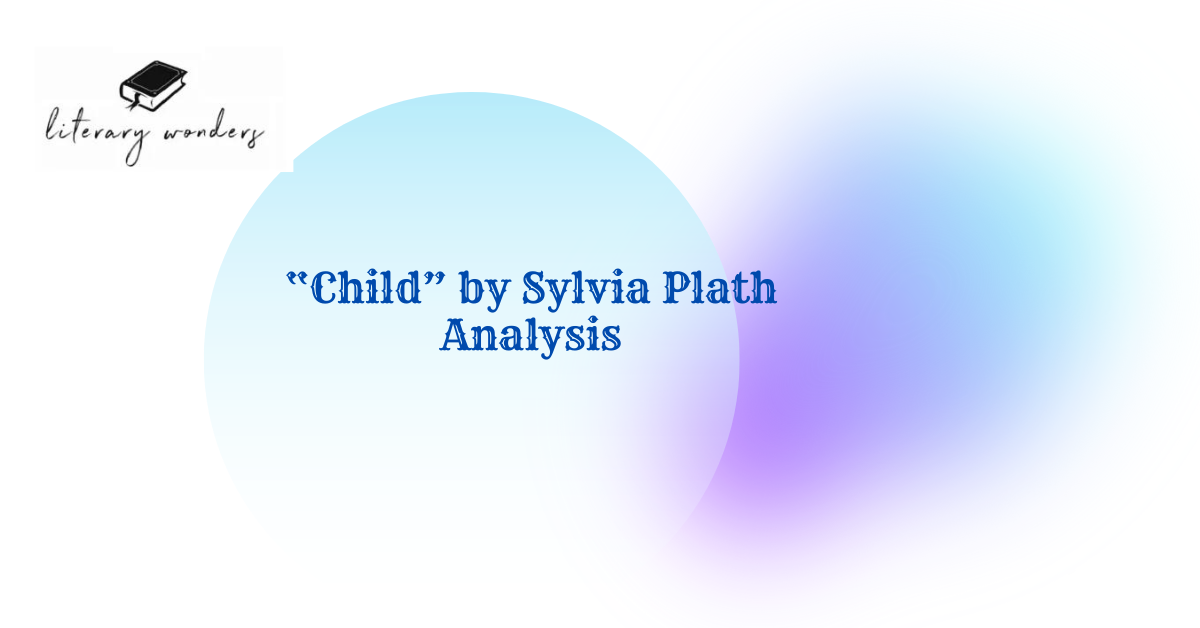· Introduction of “Child” by Sylvia Plath
Child by Sylvia Platy is a metaphorical poem. The poem sheds light on the mother’s sentiments like how she wants her child to embrace the colourful world. Also, the poem presents the worry of a mother about how she wants to keep him away from the troubles she is facing in life. Due to its universal appeal, the poem became a part of various curriculums across the globe.
· “Child” by Sylvia Plath As a Representative of Worry
This poem is written from a mother’s perspective. In the opening stanza of the poem, she adores the beauty of her child and wants to fill her clear eyes with colours. She calls out the name of absolutely beautiful things around the world to show her hopes for her child Words like Indian pipe and April snowdrop show how she wants her child to continue to live a bright and happy life. However, the second stanza talks about the pain she is going through in life. Words such as, wringing of hands, ceiling without a star shows that the speaker’s life is full of tests and trials. Therefore, she hopes that her child will get the best in life. She believes that the world is full of beauty and wonders and wants her child to be the part of this beauty.
· Major Themes in “Child”
The poem centres on themes of a mother’s love, care, and the beauty of the world. It is elegantly structured into two parts. In the first part, Sylvia Plath describes the beautiful aspects of life and expresses her hopes for a bright future for her child. The second part shifts to a more sombre tone, where she reflects on her own troubled life and conveys her worries for her child’s future, hoping that her child will be spared from the world’s darkness. Plath holds on to the belief that the world’s wonders will enable her child to experience its joys.
Analysis of Literary/Poetic Devices in Child
Literary and poetic devices add depth, clarity, and deeper meaning to the poem. Sylvia Plath employs numerous literary techniques to convey her concerns for her child. The analysis of these devices in the poem is as follows.
- Assonance: Assonance is the repetition of vowel sounds in the same line such as the sound of /e/ in “Your clear eye is the one absolutely beautiful thing” and the sound of /o/ in “Not this troublous.”
- Alliteration: Alliteration is the repetition of consonant sounds in the same line in quick succession such as the sound of /w/ in “Stalk without wrinkle.”
- Consonance: Consonance is the repetition of consonant sounds in the same line such as the sound of /t/ in “Your clear eye is the one absolutely beautiful thing” and the sound of /w/ in “Stalk without wrinkle.”
- Enjambment: It is defined as a thought in verse that does not come to an end at a line break; rather, it rolls over to the next line. For example;
“Pool in which images
Should be grand and classical”
- Free Verse: Free verse is a type of poetry that does not contain patterns of rhyme or meter. This is a free verse poem with no strict rhyme or meter.
- Imagery: Imagery is used to make readers perceive things involving their five senses. Sylvia Plath uses imagery in this poem, such as “Your clear eye is the one absolutely beautiful thing” and “Stalk without wrinkle.”
- Metaphor: It is a figure of speech in which an implied comparison is made between different objects. The poet has used care as an extended metaphor to show how a mother wants her child to have all the world’s wonders.
- Symbolism: Symbolism uses symbols to signify ideas and qualities, giving them symbolic meanings that differ from the literal ones. The poem shows symbols of love, care, dreams, and tension.
- Tercet: A tercet is a three-lined stanza borrowed from Biblical Hebrew poetry. Here, the second and third stanzas are tercets such as;
“Stalk without wrinkle,
Pool in which images
Should be grand and classical.”
- Stanza: A stanza is a poetic form of several lines. This poem has three stanzas, each consisting of different lines.
Suggested Readings

